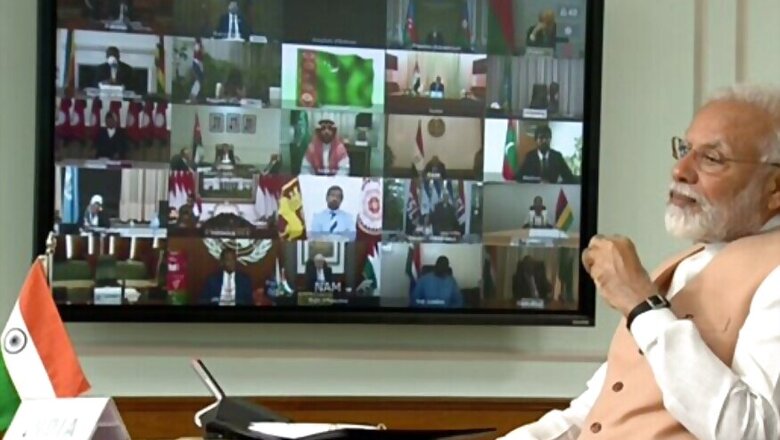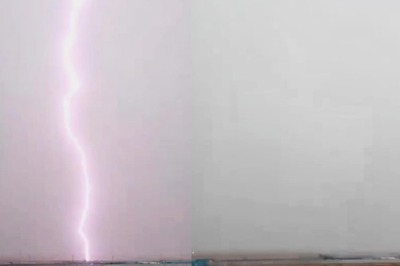
views
Prime Minister Narendra Modi has now talked to fellow NAM leaders on fighting Covid-19 fallouts together. This comes a fortnight after his initiative to talk to SAARC member-nations likewise. There is a case for India to help revive multilateralism, and thus lead in the re-activation of both institutions. However, New Delhi has to find out what needed doing to keep them alive, active and relevant, in the 21st century context.
Most other SAARC nations complain that the regional organisation is always stuck in India-Pakistan bilateral. Some outside of Pakistan even attribute the cancellation of the 19th SAARC Summit that was to be held in Islamabad in November 2016 to Indian diplomacy. They forget that Pakistan’s aid and abetment to terrorism in the region did not go down well with nations such as Bangladesh and Nepal, Sri Lanka and Maldives. They too were past or prospective victims of ISI terrorism. Their decisions were independent of one another, and also independent of Indian concerns, arising in the immediacy of Pathankot, Uri and Baramulla attacks, among others, in the that very year.
India was not only a founding-member of NAM (Non-Aligned Movement), but was also a founding spirit as Prime Ministers, Jawaharlal Nehru and Indira Gandhi breathed fresh life into NAM. After their time, India’s engagement with NAM became increasingly faulty. There were reasons for both.
Back to Cold War dynamics?
In a post-WWII world in the 1950s, ‘Cold War’ divisions were becoming visible, and poor, post-colonial nations needed their voices to be heard. What they could not do by the ‘quality’ of their voice, they sought to do through quantity. Or, so it seems from this distance in time.
The idea was to keep at bay both the US-led West and the Eastern bloc under the erstwhile Soviet Union. The idea may have been to use them both, or selectively, for the common good of the world as a whole. In the end, the US prevailed and the Soviet Union collapsed under its own weight, including the inherent weight of self and internal contradictions. The NAM, where balancing the super-powers and balancing them off was the game, lost purpose and relevance.
Democratic Socialism
Post-colonial Third World nations inherited their ‘liberal democracy’ from their European masters. At the same time, stark poverty at home influenced their leaders to prefer the Soviet model of ‘command economy’. They found the right mixture in independent India’s driving philosophy of ‘Democratic Socialism’.
India’s otherwise avoidable identification with the Soviet Union came with wars on its border, when an absolutely dependable voice in the UN Security Council (UNSC), became a benchmark model in bilateral relations. The command economy component died a natural death in good time, highlighted by the ‘fiscal crisis’ of 1989-90. Already, strains are showing in the alternate model of ‘market capitalism’. Post-COVID19 economic situation will decide the future course, in a substantive, if not full measure.
Likewise, India’s near-complete distancing from NAM followed the collapse of the Soviet Union, and Yeltsin-led Russia’s inability to stand by economic commitments of the Kudremukh and Koodamkulam kinds. More importantly, Moscow reneged on the Soviet-era commitment to supply cryogenic engines for the Indian space programme. India had to then count on American ‘say-so’ for Russia to execute past promises.
Roles reversed
Yet, the loss of credibility of NAM in international affairs had begun with the exit of its founding-fathers, one after the other. Their successors in individual nations had their own domestic compulsions to switch geo-political gears, based on their respective nations’ economic aims. The US had deep-pockets and was willing to spend. The Soviet Union did spend on allies, but only after they had committed themselves. Even then, the Soviet sparse spending could not feed the ambitions of aspirational generations in host-nations.
Today, the roles are reversed. China has deeper pockets, than possibly the US. Or, at least they are willing to invest heavily in developing countries. Unlike the US, for which ‘human rights’ and such other eclectic ideals are still elastics to be used to arm-twist nations, Beijing does not care about the internal affairs of nations.
Nor is it known to use such ideals, including forgotten communism, as a tool to make recipient-nations fall in line. China is an authoritarian nation, and it suits such other Third World autocracies to have China as a friend. They also don’t care much about their own nations slipping into a ‘debt-trap’, but they need a guaranteed under-writer in international fora such as the UNSC and UNHRC. China fits the bills, where the Soviet Union used to be.
In recent years, in nations like Myanmar, Sri Lanka and to a greater or lesser extent in Maldives in the immediate Indian neighbourhood, China has also displayed an uncanny knack to doing business with the leaderships that the local people elect or vote out. Earlier, China was not thought to be able to make this transition.
In all three nations and elsewhere too, having seemingly wedded to certain ideals and identified certain local leaderships with them, the US is unable to distance itself completely and comfortably from them as and when the local populations elect new leaders. The baggage can upset America’s relations with these nations, and it will negatively work in China’s favour over the short and medium terms.
India’s predicament
What is true of these three Indian neighbours and also Afghanistan, where India’s political role in helping to resolve the domestic crisis is indeterminable, is also true of most, if not NAM nations. Some of them are now going through a transition phase, unsure of where they stand now, or where they may and would have to stand in geo-political and geo-strategic affairs in the medium and long terms. The role of geo-economics in the post-pandemic era may be a major determinant.
The Indian predicament flows from specific factors. Firstly, it does not as yet have as deep pockets as deep instincts and empathy it continues to have for fellow SAARC and NAM nations. Consequently, it is also caught up with issues flowing from New Delhi’s out-sourcing of economic requirements of neighbourhood nations especially to the US, Japan and Australia, among others. This is independent of whatever the European Union (EU), for instance, may be doing.
India cannot take on China in the economic department, in the foreseeable future, to be able to aid and assist needy Third World nations as much. Over the past decades, India’s fellow-travellers in the Quad grouping also have exposed their limitations int his regard. They have also not been able to break China’s political vice-grip on Third World nations. Does it mean India should extricate itself, at least politically from its western ‘allies’ and revert to the post-Independence geo-political dynamics, where it spoke for the Third World as a whole, and was accepted as their voice, by all concerned?
New Delhi needs to do a lot in this matter. It may have to begin by carefully delineating political and economic components to Third World nations, and devise strategies that are not only nation-centric but also group-centric. It is not going to be easy, either for India to draft such a course, nor for fellow NAM nations to accept New Delhi without the hand-over of past suspicions.
Prime Minister Narendra Modi’s absence from the last NAM Summit at Margarita, Venezuela, in 2016, did not go unnoticed. It was also seen as the post-reforms India’s continued indifference towards NAM. His more recent use of the NAM online summit to target Pakistani terrorism was mostly drowned in the domestic cacophony over COVID19.
This article first appeared in ORF


















Comments
0 comment